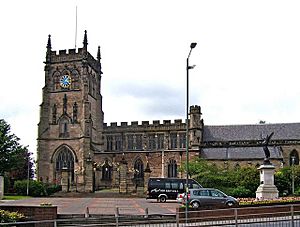St Mary and All Saints' Church, Kidderminster facts for kids
Quick facts for kids St Mary's, Kidderminster |
|
|---|---|
| St Mary and All Saints, Kidderminster | |

St Mary's church, Kidderminster
|
|
| 52°23′25.11″N 2°15′2.83″W / 52.3903083°N 2.2507861°W | |
| Location | Kidderminster |
| Country | England |
| Denomination | Church of England |
| Website | https://www.achurchnearyou.com/church/18775/ |
| History | |
| Dedication | St Mary All Saints' |
| Architecture | |
| Heritage designation | Grade I listed |
| Designated | 20 October 1952 |
| Specifications | |
| Length | 215 feet (66 m) |
| Floor area | 1,028 square metres (11,070 sq ft) |
| Administration | |
| Parish | Kidderminster Ismere |
| Deanery | Kidderminster |
| Archdeaconry | Dudley |
| Diocese | Diocese of Worcester |
St Mary and All Saints’ Church in Kidderminster, England, is a very old and important church. It is a Grade I listed building, which means it's considered a special historical site. This church is part of the Church of England.
History of the Church
Early Beginnings and Building Work
The church's history goes way back to 1086. That's when it was mentioned in the Domesday Book. This book was a huge survey of England ordered by William the Conqueror. It helped him understand what land and resources he had.
The main church building you see today was built much later. Most of it comes from the 1400s and 1500s.
The English Civil War and Richard Baxter
In 1641, during the English Civil War, something interesting happened. The vicar, George Dance, agreed to pay a preacher. This preacher would be chosen by a group of people.
Richard Baxter, a famous preacher, was invited to speak. Everyone liked him, and he became the minister of St Mary and All Saints' Church.
Changes and Updates Over Time
The church has been updated many times. In 1847, a new entrance was made under the tower. Old seating areas were removed to make the church feel more open. New oak seats were added in the south aisle.
The organ chamber was built in 1874. Later, from 1893 to 1895, the church tower was repaired and refaced. This work was done by an architect named J.A. Chatwin.
More recently, the Whittall Chapel was added in 1921-1922. This chapel was designed by Giles Gilbert Scott. The inside of the church was also rearranged between 1988 and 1990.
Kidderminster's Civic Church
St Mary and All Saints is known as the main civic church for Kidderminster. It is part of a group of churches called the Kidderminster Ismere team. This team includes several other local churches.
The Church Organ
Getting a New Organ in 1848
In 1846, the church decided to get a new organ. The old one was at the back of the church. It blocked the view of a window.
The church also wanted the organ moved to help a new choir. This choir was going to sing full church services on Sundays. A new organ was built by George Holdich. It was first played on June 7, 1848.
Modern Organ Features
Over the years, the organ has been rebuilt and improved. Today, it is a large pipe organ with three keyboards and pedals. The beautiful wooden case around the organ was added in 1927-1928. This was also designed by Giles Gilbert Scott.
There is also a separate pipe organ in the Whitall Memorial Chapel. You can find details about both organs on the National Pipe Organ Register.
Organists of St Mary's
Many talented musicians have played the organ at St Mary's. Here are some of them:
- Mr. Fletcher (1813 - 1843)
- Mrs. W.H. Fletcher (1843)
- Dr. William Marshall (1846 - 1868)
- William Taylor (1868 - 1903)
- Alfred Chatfield (1903 - 1949)
- Mr. Lashford (around 1952)
- Angela Cattanach-Chell (around 1983-1984)
- Stanley Mitchell (1985 - 2003)
- James Bradley
Church Bells
Early Bells and Repairs
By 1774, the church had a set of 8 bells. Some of these bells were made in 1754. In 1856, one of the bells broke. It was recast, or remade, in 1857.
Tower Restoration and New Bells
A big storm in October 1881 damaged the church tower. It was important to fix the tower quickly. During this repair, new floors were put in for the bells and for a clock.
A new frame was built to rehang the bells. Three new fixed bells were also added. These were part of a set of carillon chimes. These chimes played every three hours. They had different tunes, some secular and some sacred.
The Bells Today
Today, the tower has a ring of 12 bells. An extra bell was added in 2003. All these bells were made by John Taylor of Loughborough. They were officially dedicated on February 29, 2004. The largest bell weighs about 2,856 pounds (1,295 kg).
The Church Clock
An Early Clock and Its Problems
In 1828, a new clock was made for the church. It was a large clock with a pendulum that weighed 100 pounds (45 kg). This pendulum was 13 feet (4 meters) long! An extra clock face was put on the west side of the tower.
The clock was repaired in 1852. A person was even hired to wind it every year. However, the clock didn't work very well.
A New Clock for the Church
Just over a year later, people started collecting money for a brand new clock. By June 1856, a new clock was being installed. This clock was designed to strike the quarter hours. The church planned to give the old clock to St John's Church, Kidderminster.

